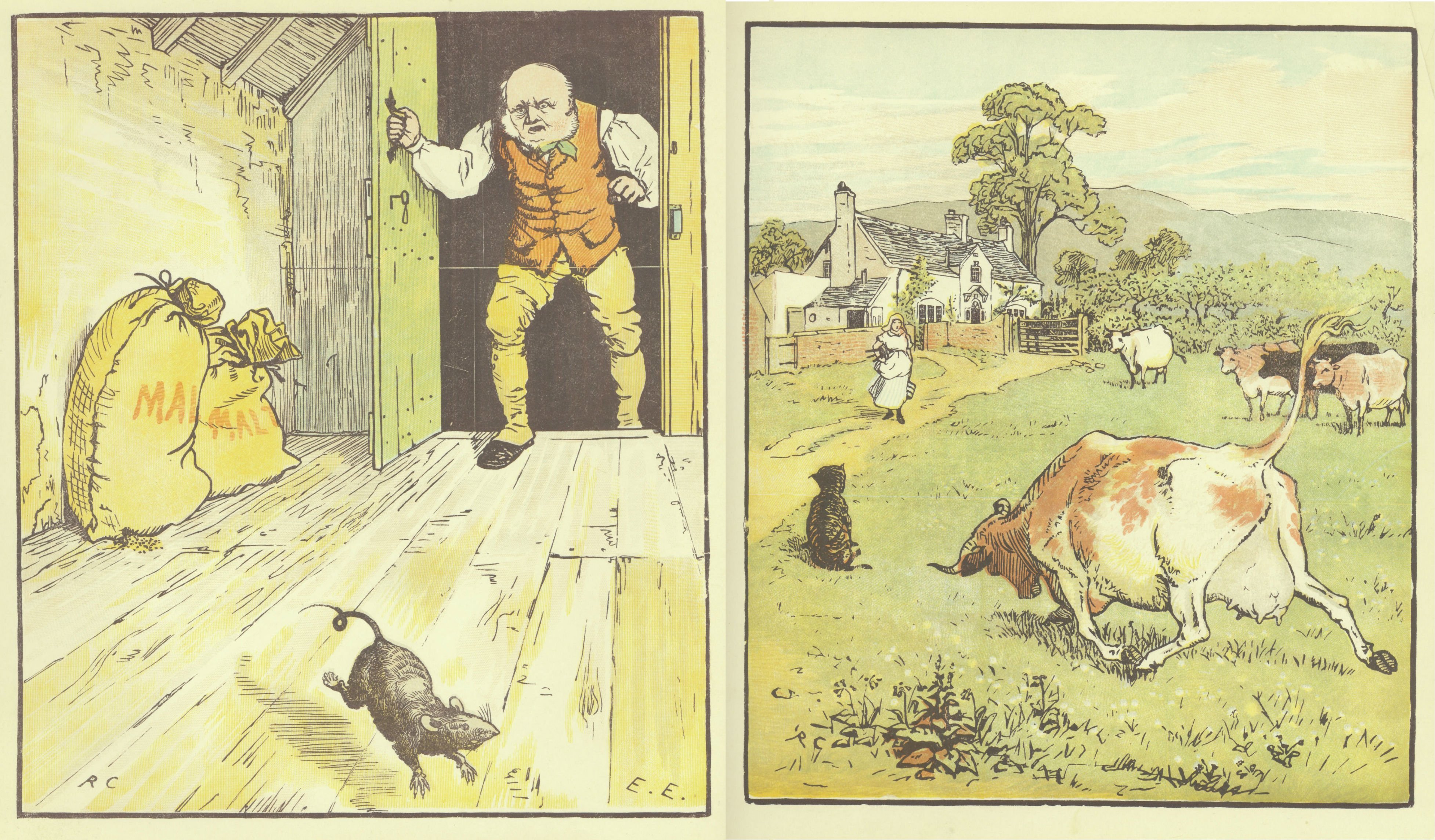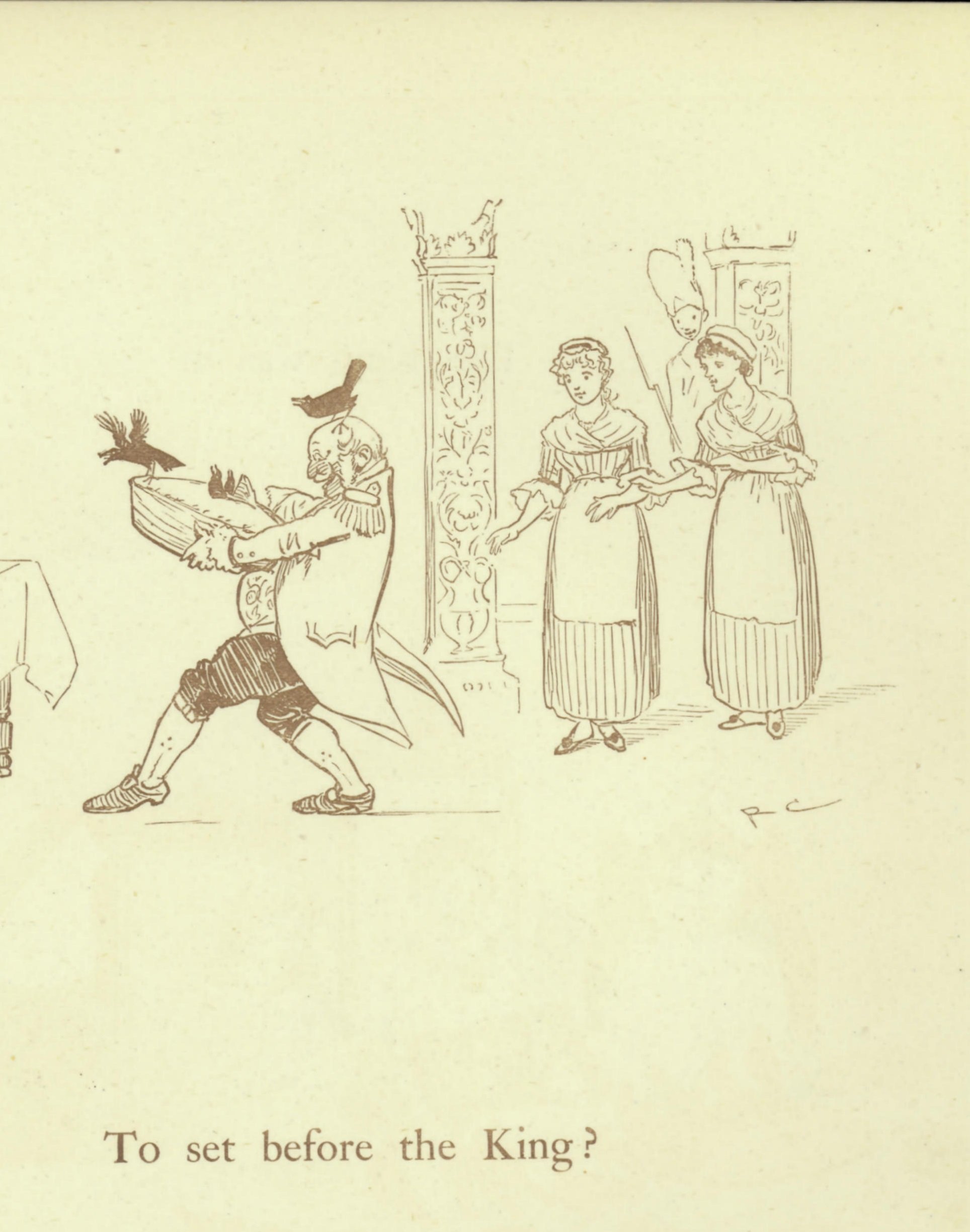Randolph Caldecott (1846-1886) broke late 19th century conventions of children’s book illustration by interpreting stories rather than decorating them, peopling them with cheeky caricatures involved in chaotic escapades.
Caldecott came to the British master printer Edmund Evans’ notice in 1877 and was immediately commissioned to illustrate two children’s books published the following year: The house that Jack built and The diverting history of John Gilpin. This began the series of sixteen children’s books illustrated by Caldecott in eight years, initially limited to print runs of 6000. Subsequent demand for additional reprinting made Caldecott both rich and internationally famous.

The house the Jack built, from R. Caldecott’s first collection of pictures and songs, ca. 1880–89
His first children’s book The house that Jack built (1878) consists of a myriad of caricatures from an imagined 18th century countryside with manor houses, hunting fields and peasants. The chaos is inherent in this cumulative rhyme, shown here with just two of the action filled scenes: the rat that ate the malt and the cow that tossed the dog.

The pie to set before the King, Sing a song of sixpence, 1880
Such an unconventional illustrator had a seemingly conservative early life. Randolph Caldecott was born in Chester, England, son of an accountant. He became a bank clerk in 1861 in Whitchurch, 20 miles south of Chester. During both his school days and his bank employment, Caldecott had considerable leisure time which he spent sketching the local countryside, fishing, making drawings at shooting meets, markets and cattle fairs. In 1867 the bank transferred him to Manchester where he joined the local art movement and made further sketches of characters in the murky streets of Manchester.

The Fox and the Stork, Some of Aesop’s fables, 1883
Caldecott moved to London in 1872 and studied at the Slade School of Art. He began to work full time as an illustrator of books and magazines including Punch, London Society and the London based Graphic magazine.
Renowned children’s book illustrator Maurice Sendak admired Caldecott’s art immensely and describes him as being ‘endowed with a fabulous sense of lively animation’ (The Randolph Caldecott Treasury p. 11). Caldecott’s characters may at first seem quite passive but would ultimately leap into action across the page. Such is the case with the sedate imagery that opens The Queen of Hearts then moves to an uproar of elaborate and comical complications when the Knave slips the stolen tarts up his sleeve.

Ride a cock horse to Banbury Cross, ca. 1880
The same riotous movement is seen in reverse order in Ride a cock horse to Banbury Cross. This rhyme opens with the sketch of three companions on a robust gallop, then moves to the calm of the fine lady with rings on her fingers and bells on her toes. The interplay of line drawings with coloured images serve to enrich the colour pictures, seen here in The great Panjandrum himself.

Line drawings and coloured images from The great Panjandrum himself.
Sendak concludes:
‘Caldecott never tells half-truths about life, and his honest vision, expressed with such conviction and robust energy, is one that children instinctively recognize and appreciate as true to their own lives.’ (p. 14.)
References
- Randolph Caldecott (1846-1886) Victorian web: literature, history and culture in the era of Victoria
- The Randolph Caldecott Treasury, edited by Elizabeth T. Billington, Frederick Warne, London, 1978.
- Randolph Caldecott: a personal memoir of his early art career, by Henry Blackburn, Sampson, Low, Marston, Searle and Rivington, London, 1887.
- Yours pictorially: illustrated letters of Randolph Caldecott, edited by Michael Hutchins, Frederick Warne, London, 1976.
To pursue more research on the Library’s Children’s Literature Research Collection go to the Children’s Literature Research Guide



I like these illustrations they are great. Wish I could do similar. Wish to see more of same
Hi Ivan,
Caldecott’s illustrations combine movement with humour while maintaining a sense of space. I had a lot of fun selecting images for this blog and I’m glad you like them. I hope they prove to be inspirational for you.
regards,
Juliet
Thanks this helped me for my class presentation.
Great to hear Mobina!
Paul